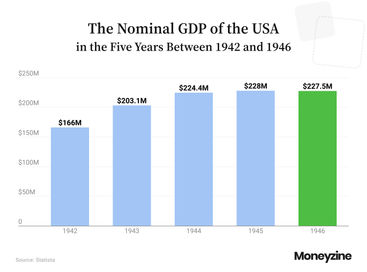
The ender of worlds or the ender of wars, J. Robert Oppenheimer, led the most important scientific effort of the 20th century. The Manhattan Project remains one of the most controversial and thought-provoking topics in history, even nearly 100 years after its inception.
But how much did the Manhattan Project cost, and what would its budget look like with today’s money? You can learn that, and much more in our short, yet packed with data, article below.
How much did the Manhattan Project cost?
$2 billion is the figure people often use to approximate the Manhattan Project’s costs. According to the Brookings Institute, the grand total of the Manhattan Project after the war ended amounted to $1,889,604,000, so that’s a more precise estimation.
Data also reveals that the majority of the Manhattan Project’s budget was used for the research of fissile material, while only a “small bit” of money was used to produce weapons of mass destruction. Let’s take a deeper look into how the funds were allocated.
Manhattan Project Cost Breakdown
Data suggests that $1,188,352,000, or almost two-thirds of the budget, was spent on the Oak Ridge facilities, which primarily focused on the production of enriched uranium and plutonium, the two key fissile materials used in the atomic bombs.
Oak Ridge, then known as the “Secret City”, was home to five separate facilities that spent the following amounts:
K-25 (Gaseous Diffusion Plant) – $512,166,000;
Y-12 (Electromagnetic Plant) – $477,631,000;
Clinton Engineer Works (HQ and central utilities) – $155,951,000;
Clinton Laboratories – $26,932,000;
S-50 (Thermal Diffusion Plant) – $15,672,000.
Furthermore, the cost of the Manhattan Project also includes the costs of additional departments and production complexes, including:
Hanford Engineer Works – $390,124,000;
Special Operating Materials – $103,369,000;
Los Alamos Project – $74,055,000;
Research and Development – $69,681,000;
Government Overhead – $37,255,000;
Heavy Water Plants – $26,768,000.
Overall, about 80% of the money went toward the sites and facilities that produced the fissile materials, while the infamous Los Alamos Project that Oppenheimer was in charge of, only spent 4% of the money to design and build the first atomic bomb.

How much of the US GDP did the Manhattan Project cost?
Looking at these figures from today’s point of view might not look like much, as $2 billion nowadays can’t even buy an elite sports club, let alone fund the project that ended the worst war in history.
However, at the time, the cost of the Manhattan Project was considered a monumental and unprecedented undertaking. The $1.889 billion budget for the project was a significant portion of the US economy during the World War II era.
Namely, historical data indicates that the nominal GDP of the USA in the five years between 1942 and 1946 was as follows:
1942 – $166 billion;
1943 – $203.1 billion;
1944 – $224.4 billion;
1945 – $228 billion;
1946 – $227.5 billion.

In total, the USA had a GDP of $1.049 trillion in the five years the Manhattan Project was funded. Knowing that the total cost of the Manhattan Project was $1.889 billion, that’s 0.18% of the USA's total GDP during the five-year period between 1942 and 1946.
In comparison, the total US GDP for the five years leading up to 2022 was $111.75 trillion, so 0.18% of that would be about $201.15 billion. That’s not to say that the Manhattan Project would be a $200 billion project today, but to simply illustrate the magnitude of a small fraction of the worth of five-year GDP.
How much would the Manhattan Project cost today?
If you are wondering what would all of these costs look like today, let’s look at them adjusted for inflation. The cumulative rate of inflation between 1946 and 2023 is 1464.7%.
This means that:
The Manhattan Project total cost of $ 1,889,604,000, would be $29,565,907,017 in today’s money.
The total expenditures of the highest spender, Oak Ridge, would increase from $1,188,352,000 to $18,593,686,685.
The most popular Los Alamos project, which manufactured the bomb, would cost $1,158,710,102, rather than $74,055,000.
Moreover, the $29,565 billion cost from the total US GDP for the five years leading up to 2022 of $111.75 trillion would be much more insignificant, at 0.03%. This is because of the considerable growth and expansion of the US economy over the years.
What was Oppenheimer’s salary for the Manhattan Project?
According to letter correspondence between J. R. Oppenheimer and the president of Berkeley University, Dr. R. G. Sproul, published in the 1983 winter/spring edition of the Los Alamos science journal, the father of the atomic bomb was paid $10,000 a year for leading the Manhattan Project.
That was about four times more than the $200 per month he got as a physics professor at the University of California and the California Institute of Technology.
Using the same cumulative inflation rate of 1464.7% we used to determine the cost of the Manhattan Project in today's dollars, Oppenheimer’s compensation for creating the atomic bomb adjusted for inflation would be $156,466 in 2023. That’s comparable to what marketing and sales managers make, according to the latest report by the US Bureau of Labour Statistics.
The Bottom Line
While we can’t say whether or not it was morally right or wrong, now you know how much the Manhattan Project cost so that you can get another perspective on the matter. Of course, these are just the financial costs, but the historical significance of this project extends far beyond monetary value. The project’s cost in terms of human lives and ethical implications can’t be quantified, so we leave that debate to you.
Sources:


.jpg)


